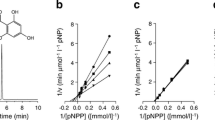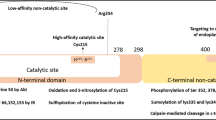Abstract
PTP1B is a negative regulator of insulin signaling pathway. This study investigated the effects of compound CCF06240, a PTP1B inhibitor, on insulin sensitivity and lipid metabolic abnormalities in vivo and in vitro, respectively. The insulin resistant IRM mouse model was induced by HFD. The responses to insulin were determined by OGTT, ITT, and hyperinsulinemic–euglycemic clamp test. The body weight and the levels of serum TC and TG were measured to estimate the lipid metabolism in vivo. Recombinant human GST-PTP1B protein was used to measure the inhibition of CCF06240 on PTP1B activity. The hepatocyte lipid accumulation was induced by high concentrations of FFA and insulin in HepG2 cells, and evaluated by the Oil Red O method. In IRM mice, the insulin resistance was improved; the body weight and the levels of TC and TG were also reduced by oral CCF06240 administration. In lipid accumulated model cells, CCF06240 was found to reverse the increased PTP1B activity, enhance the insulin-induced tyrosine phosphorylation in insulin signaling pathway, attenuate the FFA-insulin-induced cellular lipid accumulation, and down-regulate the expressions of genes related fatty acid synthesis. These results demonstrated that the PTP1B inhibitor, compound CCF06240, could increase insulin sensitivity through the regulation of insulin signaling pathway, and decrease FFA-insulin-induced hepatocytes lipid accumulation by reducing fatty acid syntheses.





Similar content being viewed by others
Abbreviations
- ACCβ:
-
Acetyl coenzyme A carboxylase β
- AUC:
-
Area under curve
- Con:
-
Control
- FAS:
-
Fatty acid synthase
- GIR:
-
Glucose infusion rate
- HFD:
-
High-fat-diet
- ITT:
-
Insulin tolerant test
- IR:
-
Insulin receptor
- IRM:
-
Insulin resistance model
- IRS:
-
Insulin receptor substrate
- OGTT:
-
Oral glucose tolerant test
- PTP1B:
-
Protein tyrosine phosphatase 1B
- pNPP:
-
p-Nitrophonyl phosphate
- Rosi:
-
Rosiglitazone
- RT-PCR:
-
Reverse transcription polymerase chain reaction
- SREBPs:
-
Sterol response element-binding proteins
References
Bruce KD, Hanson MA (2010) The developmental origins, mechanisms, and implications of metabolic syndrome. J Nutr 140(3):648–652
Saltiel AR, Kahn CR (2001) Insulin signalling and the regulation of glucose and lipid metabolism. Nature 414(6865):799–806
Van Gaal LF, Mertens IL, De Block CE (2006) Mechanisms linking obesity with cardiovascular disease. Nature 444(7121):875–880
Bloomgarden ZT (2007) Insulin resistance, dyslipidemia, and cardiovascular disease. Diabetes Care 30(8):2164–2170
Weickert MO, Pfeiffer AFH (2006) Signaling mechanisms linking hepatic glucose and lipid metabolism. Diabetologia 49(8):1732–1741
Johnson TO, Ermolieff J, Jirousek MR (2002) Protein tyrosine phosphatases 1B inhibitors for diabetes. Nat Rev Drug Discov 1(9):696–709
Zhang Z (2002) Protein tyrosine phosphatases: structure and function, substrate specificity, and inhibitor development. Annu Rev Pharmacol Toxicol 42:209–234
Wrobel J, Sredy J, Moxham C, Dietrich A, Li Z, Sawicki DR, Seestaller L, Wu L, Katz A, Sullivan D, Tio C, Zhang ZY (1999) PTP1B inhibition and antihyperglycemic activity in the ob/ob mouse model of novel 11-arylbenzo[b]naphtho[2,3-d]furans and 11-arylbenzo[b]naphtho[2,3-d]thiophenes. J Med Chem 42(17):3199–3202
Ye F, Tao R, Cong W, Tian J, Liu Q (2008) Utilization of fluorescence tracer in hyperinsulinemic–euglycemic clamp test in mice. J Biochem Biophys Method 70(6):978–984
Hwang JT, Park IJ, Shin JI, Lee YK, Lee SK, Baik HW, Ha J, Park OJ (2005) Genistein, EGCG, and capsaicin inhibit adipocyte differentiation process via activating AMP-activated protein kinase. Biochem Biophys Res Commun 338(2):694–699
Rector RS, Thyfault JP, Wei Y, Ibdah JA (2008) Non-alcoholic fatty liver disease and the metabolic syndrome: an update. World J Gastroenterol 14(2):185–192
Farrell GC, Larter CZ (2006) Nonalcoholic fatty liver disease: from steatosis to cirrhosis. Hepatology 43(2 Suppl 1):S99–S112
Delibegovic M, Bence KK, Mody N, Hong EG, Ko HJ, Kim JK, Kahn BB, Neel BG (2007) Improved glucose homeostasis in mice with muscle specific deletion of protein-tyrosine phosphatase 1B. Mol Cell Biol 27(21):7727–7734
Zinker BA, Rondinone CM, Trevillyan JM et al (2002) PTP1B antisense oligonucleotide lowers PTP1B protein, normalizes blood glucose, and improves insulin sensitivity in diabetic mice. Proc Natl Acad Sci USA 99(17):11357–11362
Xue B, Kim YB, Lee A, Toschi E, Bonner-Weir S, Kahn CR, Neel BG, Kahn BB (2007) Protein-tyrosine phosphatase 1B deficiency reduces insulin resistance and the diabetic phenotype in mice with polygenic insulin resistance. J Biol Chem 282(33):23829–23840
Klaman LD, Boss O, Peroni OD et al (2002) Increased energy expenditure, decreased adiposity, and tissue-specific insulin sensitivity in protein-tyrosine phosphatase 1B-deficient mice. Mol Cell Biol 20(15):5479–5489
Kumar A, Ahmad P, Maurya RA, Singh AB, Srivastava AK (2009) Novel 2-aryl-naphtho[1, 2-d]oxazole derivatives as potential PTP-1B inhibitors showing antihyperglycemic activities. Eur J Med Chem 44(1):109–116
Koteish A, Diehl AM (2001) Animal models of steatosis. Semin Liver Dis 21(1):89–104
Cong WN, Tao RY, Tian JY, Liu GT, Ye F (2008) The establishment of a novel non-alcoholic steatohepatitis model accompanied with obesity and insulin resistance in mice. Life Sciences 82:983–990
Araya J, Rodrigo R, Videla LA, Thielemann L, Orellana M, Pettinelli P, Poniachik J (2004) Increase in long-chain polyunsaturated fatty acid n-6/n-3 ratio in relation to hepatic steatosis in patients with non-alcoholic fatty liver disease. Clin Sci (Lond) 106(6):635–643
Shimomura I, Shimano H, Korn BS, Bashmakov Y, Horton JD (1998) Nuclear sterol regulatory element-binding proteins activate genes responsible for the entire program of unsaturated fatty acid biosynthesis in transgenic mouse liver. J Biol Chem 273(52):35299–35306
Towle HC, Kaytor EN, Shih HM (1997) Regulation of the expression of lipogenic enzyme genes by carbohydrate. Annu Rev Nutr 17:405–433
Fukuda H, Iritani N, Sugimoto T, Ikeda H (1999) Transcriptional regulation of fatty acid synthase gene by insulin/glucose, polyunsaturated fatty acid and leptin in hepatocytes and adipocytes in normal and genetically obese rats. Eur J Biochem 260(2):505–511
Acknowledgments
The authors thank Dr. Maegawa in Shiga Medical University (Japan) for the HepG2 cells and Servier Company (France) for the PTP1B plasmid as the kindly gifts. The authors also thank National Science & Technology Major Project (No. 2009ZX09103-432, 2009ZX09303-003) and Natural Sciences Funds of Inner Mongolian Autonomous Region (No. 20080404Zd31) for the financial support.
Conflict of interest
None.
Author information
Authors and Affiliations
Corresponding author
Rights and permissions
About this article
Cite this article
Ma, Ym., Tao, Ry., Liu, Q. et al. PTP1B inhibitor improves both insulin resistance and lipid abnormalities in vivo and in vitro. Mol Cell Biochem 357, 65–72 (2011). https://doi.org/10.1007/s11010-011-0876-4
Received:
Accepted:
Published:
Issue Date:
DOI: https://doi.org/10.1007/s11010-011-0876-4




